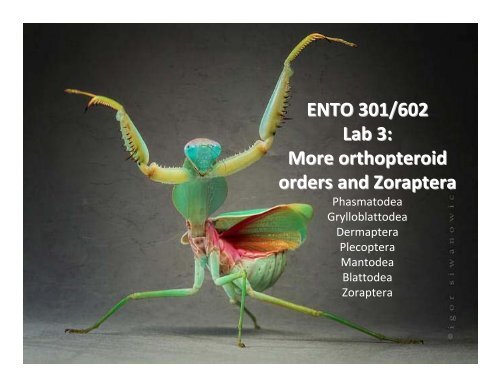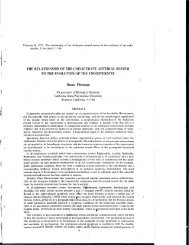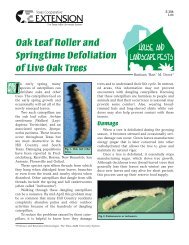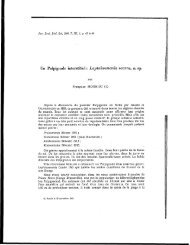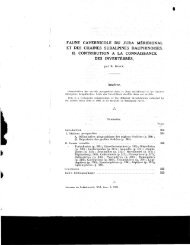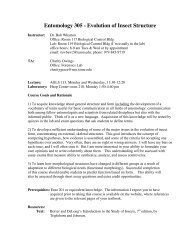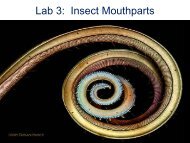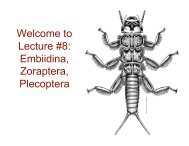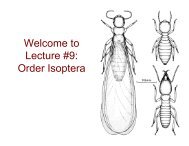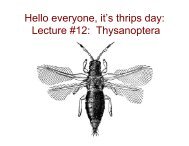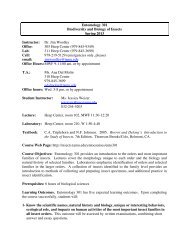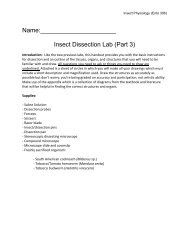ENTO 301/602 Lab 3: More orthopteroid orders and Zoraptera
ENTO 301/602 Lab 3: More orthopteroid orders and Zoraptera
ENTO 301/602 Lab 3: More orthopteroid orders and Zoraptera
You also want an ePaper? Increase the reach of your titles
YUMPU automatically turns print PDFs into web optimized ePapers that Google loves.
<strong>ENTO</strong> <strong>301</strong>/<strong>602</strong><br />
<strong>Lab</strong> 3:<br />
<strong>More</strong> <strong>orthopteroid</strong><br />
<strong>orders</strong> <strong>and</strong> <strong>Zoraptera</strong><br />
Phasmatodea<br />
Grylloblattodea<br />
Dermaptera<br />
Plecoptera<br />
Mantodea<br />
Blattodea<br />
<strong>Zoraptera</strong>
<strong>Lab</strong> exam:<br />
20 families for sight‐ID<br />
(closed‐book)<br />
~5 key‐out specimens<br />
(can use textbook)
Bug Name Mnemonics<br />
• Know what order <strong>and</strong>/or suborder you are studying<br />
• Break up the term/name, know it’s meaning<br />
• Say the names out loud<br />
• Write them down (more than once)<br />
– This WILL lead to better spelling<br />
• Make sure you can see the characteristics<br />
– Make a glossary/word bank with the new terms you come across<br />
when studying each group<br />
• Review characteristics even after you key out a specimen<br />
• Take an order <strong>and</strong> determine why each family within it is<br />
different (I.E. COMPARE, COMPARE, COMPARE!)
Your <strong>Lab</strong> Routine<br />
•Try to bring a print copy of the lab PPT (or<br />
load it in your laptop/tablet)<br />
•List “new” words you come across during the<br />
presentation <strong>and</strong> the keys <strong>and</strong> try to write<br />
definitions in your own words<br />
• Run the keys to learn important characters,<br />
don’t just rely on the family diagnoses<br />
•Write the family names at least once (yes, even if it’s<br />
already written on your h<strong>and</strong>out)
Field Trip<br />
Announcements
•Active<br />
Collecting Techniques<br />
• Sweeping<br />
•Beating<br />
•H<strong>and</strong> collecting<br />
•Light collecting<br />
http://insects.tamu.edu/students/undergrad/ento489_field/<br />
http://tinyurl.com/ento489<br />
•Passive<br />
• Malaise Traps<br />
• Berlese Funnel<br />
•Pit‐fall traps<br />
•Yellow pan traps<br />
http://www.ars.usda.gov/SP2UserFiles/ad_hoc/12754100Collecting<strong>and</strong>PreservingInsects<strong>and</strong>Mites/collpres.pdf<br />
http://tinyurl.com/coll‐manual
Sweeping net<br />
Aquatic net<br />
Malaise Flight Interception Pitfall<br />
Light<br />
Beating sheet<br />
Yellow pan<br />
(Moericke)<br />
Leaf litter sifting
poor man’s collecting equipment
<strong>Lab</strong> 3<br />
Phasmatodea<br />
Pseudophasmatidae<br />
*Heteronemiidae<br />
*Grylloblattodea<br />
*Grylloblattidae<br />
Dermaptera<br />
Forficulidae<br />
Anisolabididae<br />
<strong>Lab</strong>iduridae<br />
*<strong>Zoraptera</strong><br />
*Zorotypidae<br />
Plecoptera<br />
Perlidae<br />
Nemouridae<br />
Mantodea<br />
Mantidae<br />
Blattodea<br />
Blattellidae<br />
Blattidae<br />
Polyphagidae<br />
* = grad only
Order Phasmatodea<br />
• All legs unmodified<br />
• Tarsi usually 5‐segmented<br />
• Short cerci; short, concealed<br />
ovipositor<br />
• Herbivores with biting/chewing<br />
mouthparts<br />
• North American species usually<br />
wingless, stick‐like<br />
• No tympana <strong>and</strong><br />
stridulatory organs
Family Pseudophasmatidae<br />
(striped walking sticks)<br />
• Mesothorax never more than 3 times as long as the<br />
prothorax
Family Heteronemiidae<br />
(common walking‐sticks)<br />
• Mesothorax at least 4<br />
times as long as<br />
prothorax
Order Grylloblatodea / Grylloblattaria<br />
[GRAD] (“rock crawlers”)<br />
•Wingless<br />
•5‐segmented tarsi<br />
•Long cerci<br />
• Antennae long, filiform<br />
•Eyes reduced or absent; no ocelli<br />
•Sword shaped ovipositor<br />
• Family Grylloblattidae ‐ DEMO
Order Dermaptera<br />
• Pincer‐like cerci<br />
• 3‐segmented tarsi<br />
• Biting/chewing,<br />
prognathous mouthparts<br />
• Fore wings, when present,<br />
reduced to short tegmina<br />
• Hind wings, when present, large<br />
<strong>and</strong> folded up beneath tegmina<br />
at rest
Family Forficulidae<br />
(European & Spine‐tailed earwigs)<br />
•Distal extension of second tarsal segment<br />
dilated <strong>and</strong> broader than third segment.<br />
• Antennae with 12‐16 segments
• Antennae with 14‐24<br />
segments<br />
•Tegminaare rounded<br />
flaps that don’t meet at<br />
inner basal margins, or<br />
absent<br />
•Right forceps of male<br />
more strongly curved<br />
than left<br />
Family Anisolabididae<br />
(Seaside <strong>and</strong> Ring‐Legged Earwigs)
Family <strong>Lab</strong>iduridae<br />
(striped earwigs)<br />
• Antennae 25‐30 segments<br />
•No dilated second tarsal segment<br />
•Pronotum light brown with 2 dark stripes
Order Plecoptera<br />
(Stoneflies)<br />
•Large, membranous fore <strong>and</strong> hind wings<br />
• Biting/chewing mouthparts, may be reduced<br />
•Long antennae<br />
•3‐segmented tarsi<br />
• Cerci present, often long<br />
• Aquatic immatures
Family Perlidae<br />
(common stoneflies)<br />
•<strong>Lab</strong>ium: glossae small, posterior to paraglossae<br />
–appears to have two terminal lobes<br />
• Remnants of gills on thorax
Family Nemouridae<br />
• <strong>Lab</strong>ium: glossae <strong>and</strong> paraglossae about the<br />
same size<br />
– appearing like 4 lobes<br />
•Wings flat at rest, with apical crossvein.
•Fore legs raptorial<br />
•Elongate prothorax<br />
•Cerci present,<br />
multi‐segmented<br />
• Usually winged,<br />
some wingless<br />
• Oothecae<br />
Order Mantodea
Family Mantidae<br />
•Pronotum distinctly<br />
longer than wide.
Order Blattodea / Blattaria<br />
•Large shield‐like pronotum<br />
•Dorsally flattened body<br />
•All legs cursorial with 5‐<br />
segmented tarsi<br />
• Biting/chewing mouthparts<br />
•Long, filiform antennae<br />
•2 pairs of wings, the<br />
forewings often tegmen‐<br />
like<br />
• Oothecae
Family Blattidae<br />
(Oriental, American cockroach,<br />
others)<br />
• Female: subgenital plate divided longitudinally;<br />
• Male: styli slender, elongate<br />
• Ventroposterior margin of front femur with spines<br />
decreasing gradually in size <strong>and</strong> length or nearly equal in<br />
length (Fig 21‐1A).
Family Blatellidae<br />
(German, wood, <strong>and</strong> others)<br />
• Female: subgenital plate entire<br />
•Male: often styli small, irregular, not noticeable<br />
• spines on femora variable (see fig 21‐1 B).<br />
UMN
• No spines on mid or hind<br />
femora for many species<br />
• Often found associated with<br />
ants <strong>and</strong> in dry<br />
environments<br />
Family Polyphagidae<br />
(s<strong>and</strong> cockroaches <strong>and</strong> others)
• Includes some very large<br />
species <strong>and</strong> some pale<br />
green in color<br />
• Usually only 1 spine on<br />
the ventroposterior<br />
margin at tip of front<br />
femora (see Fig. 21‐1)<br />
Family Blaberidae (FYI)<br />
(giant hissing cockroaches <strong>and</strong> others)
Order <strong>Zoraptera</strong><br />
[GRAD] (angel insects)<br />
•Minute, 3mm or less<br />
•Very reduced wing<br />
venation (if wings present)<br />
• Cerci present<br />
•9‐segmented antennae<br />
•2 segmented tarsi, each tarsus<br />
with 2 claws<br />
•One family: Zorotypidae
Order Mantophasmatodea (FYI)


